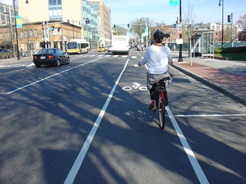Bicycle Lanes

What are Bike Lanes and Who is Permitted to Use Them?
Bicycle lanes are marked lanes in the public right-of-way that are by law exclusively for use by bicyclists. Bike lanes in Cambridge have bicycle symbols and arrows, which emphasize the correct direction of travel. Motorists are not allowed to travel in bike lanes and are subject to a $100 fine if they do so. They are allowed to cross the lanes to turn or to park. Cyclists are still permitted to travel in the regular vehicle travel lanes even when a bike lane is present. Cyclists should signal and make sure they have the attention of the people behind them before moving into the vehicle travel lane from a bike lane. Motorists should be aware that cyclists may merge into their lanes in front of them, e.g., to avoid an obstacle or to make a left turn.
Why is it Important to Stripe Bike Lanes?
As bicyclists will be traveling on city streets, those streets can be made safer and more comfortable for everyone by providing bike lanes. Bike lanes:
- Support and encourage bicycling as a means of transportation.
- Help define road space promote a more orderly flow of traffic
- Encourage bicyclists to ride in the correct direction, with the flow of traffic.
- Give bicyclists a clear place to be so they are not tempted to ride on the sidewalk
- Remind motorists to look for cyclists when turning or opening car doors
- Signal motorists that cyclists have a right to the road
- Reduce the chance that motorists will stray into cyclists’ path of travel
- Make it less likely that passing motorists swerve toward opposing traffic
- Decrease the stress level of bicyclists riding in traffic
Promoting Cycling
National and international evidence to date has demonstrated that the most important way to promote bicycle transportation is to provide bicycle facilities – safe and clear places where people can ride, including bicycle lanes. A major study sponsored by the Federal Highway Administration, for example, demonstrated that bicycle usage in urban areas is directly proportional to the percentage of arterial streets with bike lanes. US cities with high bicycling populations have 70% more bike facilities per roadway mile and six times more bike lanes per arterial than those with low bicycling populations. Further studies since have confirmed these findings, noting that bicycle commuting increased in direct proportion to the miles of bike lanes (bike lanes were the strongest variable in predicting bicycle commuting). Bicyclists have clearly stated their preference for marked bicycle lanes on roads and streets in numerous studies throughout the US. Studies have also demonstrated people's preference for separated bicycle facilities.
Enhancing Safety
Bicycle lanes have improved safety, in terms of both the number and the severity of crashes in cities throughout the US and internationally. Bike lanes have reduced crash rates for all users – bicyclists, pedestrians and motorists. Bicycle lanes also have been associated with safer bicyclist behavior – less wrong-way and sidewalk riding and more obedience to traffic controls (e.g., stop signs). For example, a national study comparing streets with bike lanes to those without found that 15% of cyclists on streets without bike lanes rode on the sidewalks, vs. 3% on the streets with bike lanes. In addition, on streets with bike lanes, 81% of cyclists obeyed stop signs, vs. 55% on streets without.
Where Bike Lanes are Created in Cambridge
The premise of bicycle transportation planning is that all roads are bikeways (except limited access highways), but the kind of facility or designation will vary depending on the street type, use (e.g., amount and type of motor vehicle traffic) and existing conditions. Bicyclists, like automobile drivers, want to get to their destinations by the most direct route available. Therefore, all streets in the city are places where safe bicycling should be enabled. This is important also because many destinations - stores, restaurants, transit stations, schools, etc. - are located along major streets. On busy streets, the appropriate facilities for bicyclists are bike lanes or cycle tracks. Designated bike facilities may also be appropriate on minor collector or local streets, especially if traffic speeds and/or volumes are higher than normally encountered, or to connect or extend facilities to desirable destination points.
The Hampshire Street Bicycle Lane Study
The City of Cambridge participated in a major study to evaluate the influence of bike lanes and other pavement markings on how motorists and bicyclists travel on the road, using Hampshire Street as the study site. The study was particularly focused on how far away bicyclists travel from parked cars, since the threat of being hit by a car door opening suddenly is a serious one. The study found that when bike lanes or other pavement markings were present, bicyclists traveled further away from parked cars than when no markings were present. On-street surveys of bicyclists and motorists were also conducted. Bicyclists overwhelmingly favored bike lanes, with 90% of them preferring the lanes, and another 5% preferring a line marking. Motorists were highly likely to identify the bike lanes as a reason they noticed bicyclists.
Click here to read a paper describing the study.
The study has been published inTransportation Research Record, Journal of the Transportation Research Board, No. 1939, “Bicycles and Pedestrians; Developing Countries,” 2005 (www.trb.org).
For More Information
For more information about bicycling in Cambridge, please contact update cddat344@cambridgema.gov.